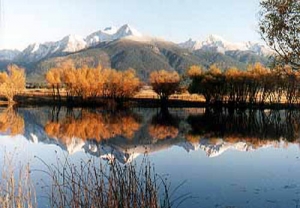Elk, whitetail deer & mule deer, geese, ducks, pheasants; hunting season has started in Montana. There are many reasons to get out and enjoy Western Montana ‘s beautiful outdoors. Even an afternoon drive or day hike to enjoy the beautiful Autumnal colors along the valleys, creeks and rivers, where all the trees are sporting a splash of color, as well as, the high mountains where the larch trees, before losing their needles, turns the mountain sides golden. Since Daylight Savings Time begins this Sunday, and the days begin to shorten, we thought we’d spend some time traveling Western Montana via narrative. In the next few weeks, we invite you to join us on a journey to the special valleys of Western Montana, in hopes that you will someday get to visit these beautiful places that we are blessed to call home.
If we leave Missoula east on I-90, we pass through the narrow Hellgate Canyon (most likely named as such because it was a favorite place of the Blackfeet Indians to ambush other tribes on their return trips from hunting buffalo on the Great Plains). Although the name might still aptly apply, as this rugged little canyon acts as a funnel for the cold east winds as they rush into the Missoula Valley. Our coldest winter weather, coming out of the arctic North, often is pushed around the mountains to the east, before seeping back into the protected valleys of Western Montana.
Just beyond the Hellgate Canyon, lies East Missoula, one of our many bedroom communities as well as Bonner and Milltown where the Blackfoot River (Big) and Highway 200 branch off to the North East – (please note: this is the exit that we will refer to, as an easier access to Garnet Ghost Town).
As we continue East, we see a couple of other small communities that are supported by Missoula; Clinton & Turah and then a few miles down the road we come to the former Bearmouth Chalet RV park. The road running behind it, takes us on a wonderful Montana adventure to Garnet Ghost Town. This is a side trip you will want to plan for late next spring or summer. Please note that the Ghost Town is more easily accessed from Hwy 200 and we recommend that you use that well graveled road, which has a more gradual climb and has spectacular mountaintop views, as you ascend ever higher. The access from the I-90 side can be very steep and treacherous. Even the last mile of the Hwy 200 road is a very narrow, windy logging road that gives you a taste of what the I-90 access is like. If you find this part of the road comfortable, and your vehicle is capable, then you may wish to exit the Ghost Town via the I-90 side.
Once you have made your way to Garnet, you will come to a true ghost town and be enthralled at how hardy and rugged these first miners had to be, to exist. The town still has about 25 buildings, some of which, like the J.K. Wells Hotel and Kelly’s Saloon, are remarkably evocative of their original day. In 1898 the town had nearly 1,000 inhabitants, four stores (Which, at the time, competed successfully with Missoula’s retail), four hotels, stables, barber shops, a candy store, a doctor’s office, and more than ten saloons. But this wasn’t your average rough-and-drunken boomtown. Because many miners had already married by the time they made it to Garnet, the town had a school. In 1898 Garnet School had 41 kids, and the town thrived on social events as much as the ore in mountains. And then, all too quickly it was gone. Typical of all boomtowns, the growth was quick and haphazard; the heyday wasn’t too long before the end. By 1905, the mines seemed played out and the town was down to 150 people. Today the ghost town remains engulfed by wilderness, and connected to it by the Garnet Byway; 12 miles of mountain road and 41 miles of trail, offering a substantial avenue from the mining-legacy of the past to the recreational opportunities of today. Scenic overlooks provide views of current and historical extraction sites, so the public may observe how the land has been used, while now its’ used for recreation.
We suggest you bring a picnic lunch with plenty of beverages (there are no convenience stores up here) a jacket and some comfortable walking/hiking shoes, and of course your camera.
About 25 miles east of Missoula, is one of Western Montana’s best Blue Ribbon trout streams – “Rock Creek” – that enters the Clark Fork River. Following the many hatches up this incredible stream, is the greatest joy of many a fly fisherman. Numerous access points and several campgrounds are readily available. On your way up or back down Rock Creek, you may want to stop for a great meal and rustic ambiance at the Ekstrom Station. Don’t forget to watch for Bighorn Sheep, on the colorful cliffs lining this relatively narrow valley.
Back on I-90, as we follow the Clark Fork River upstream, the rise in elevation is so subtle that it often goes unnoticed, but winter weather will quickly remind you. Not a high snowfall area, this doesn’t benefit from the protection of the mountains as much as other areas further west.
The valley grows larger as we travel east and at Drummond (50 miles East of Missoula), it really opens up. Drummond, (“World Famous Bull Shippers” is on a billboard, as you enter town) is a small rural, one main street town, with all the basic services including stockyards along the railroad, for shipping of area cattle to markets, far off. Stelling & Associates is proud to offer the ‘Elk View Ranch’ located nearby.

